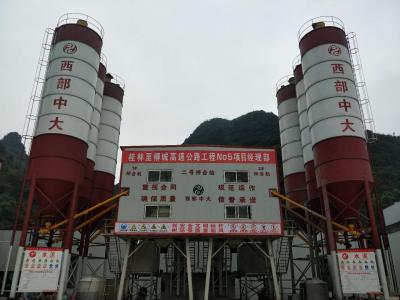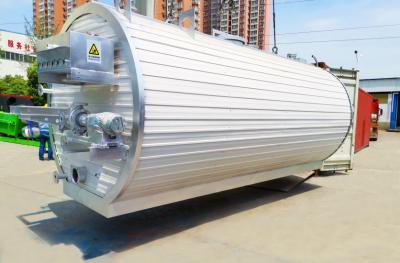Common faults of concrete mixing plant and how to deal with them
Common faults of concrete mixing plant and how to deal with them
Concrete mixing plant in the process of use, due to the aging of parts, wear and tear and environmental impact, there are often 6 errors, so deal with concrete mixing plant failure methods? How to solve common failures?
1. Cement scale weighing is not allowed
The fault is manifested as follows: add weights after calibration can display the correct value, after unloading but the figures do not return to zero, after clearing the zero and then load the weights digital change, but check the sensor resistance value in the normal range, and no problems with the instrument.
Possible causes:
Transport with fixed scale frame angle iron is not removed.
Pressure head and pressure plate at the hairpin.
Scales and outside interference with each other.
3 sensor models do not match; weighing material bias load.
Treatment:
If the angle iron used to fix the scale frame for transport is not removed, it should be removed in a timely manner.
If the pressure head or pressure plate stuck, should be processed in a timely manner, so that it is smooth and without resistance.
If the scale interferes with the outside world, it should be isolated in a timely manner.
if the 3 sensor models do not match, they should be replaced with sensors of the same model.
If the material bias load, should be adjusted.
2. The aggregate chamber discharge door without material when opening and closing difficulties
The fault is manifested as: cylinder action is slow and weak, but check the mechanical part of the discharge door without friction, stalling phenomenon, and solenoid valve, cylinder are no air leakage phenomenon.
Possible causes.
The gas path is not smooth, such as the gas source at the triplex of the gas-water separator cartridge is too dirty, causing the gas path is not smooth, so that the gas flow per unit of time is reduced, thus causing the cylinder activity slow.
2. The muffler is too dirty, in the cylinder action with rod cavity and rodless cavity pressure difference becomes small, resulting in slow cylinder action.
Treatment methods.
1、If the gas circuit is not smooth, the filter element should be cleaned or replaced in time.
2、If the muffler is too dirty, the muffler should be cleaned in time.
3、The material does not come out from the outlet
The fault is: when the contactor is closed and the motor is rotating clockwise, the material does not come out of the spiral conveyor, and the air switch trips after a long time; the air switch is closed and the motor is still tripped, and the powder is not solidified.
Possible causes:
1. The mother machine is reversed; the air switch is damaged.
2. The mother machine motor wiring may have a phase of poor contact.
Handling method.
1. If the mother machine is reversed, the mother machine motor wiring any 2 to adjust the position can be;.
2. If the air switch is damaged, it should be replaced.
3. If there is a phase of poor contact in the wiring of the mother motor, it should be checked and processed.
4. Stirring shaft "bogging down"
The fault is: when the mixing machine is mixing mortar, the mixing shaft is difficult to rotate and even stop.
Possible reasons.
1. Serious overload, material hoop shaft; human misoperation causing secondary feeding.
2. Inaccurate weighing.
3. The gap between the mixing blade or side blade and the inner wall of the tank is large, and there is a foreign body enters the stagnation between them.
4. The voltage is too low; mixing parameters set wrong.
Handling methods.
1. If it is seriously overloaded and the material hoops the shaft, the mixing capacity should be adjusted and the solidified mortar should be cleared in time.
2. If human error causes secondary feeding, excess material should be used and operated according to the process.
3. If the weighing is not allowed, the operator should be asked to re-mark the scale.
4. If there is a foreign body stuck between the mixing blade or side blade and the inner wall of the tank, the gap between the blade and the liner should be adjusted so that it is not more than 5 mm, and clean up the foreign body in time.
5.If the voltage is too low, check the line voltage again; if the parameter setting is wrong, check the corresponding dosage data carefully and correct it in time.
5. The host unloading door cannot be opened
The fault is: when the mixing plant is working automatically, the unloading door of the main machine cannot be opened, and the unloading indicator light does not light up when the mixing is finished.
Possible reasons:
1. Foreign material or material accumulation between the discharge door and the sealing plate.
2. Insufficient pressure in the air circuit system, leakage in the cylinder or damage to the oil mister.
3. The wiring between the solenoid valve and the relay off, false connection or relay damage.
4. The solenoid valve coil burned or spool stuck.
5. The time relay is damaged, resulting in no normal input signal to the PLC.
Treatment methods:
1. If there is foreign matter or material accumulation between the unloading door and the sealing plate, should clean foreign matter, material accumulation and flush the unloading door.
2. If there is insufficient pressure in the air system, leakage in the cylinder or damage to the oil mister, the oil mister, joints, cylinders and other parts should be checked for damage.
3. If the wiring between the solenoid valve and the relay off, false connection or relay damage, should check the relay contact output and wiring, if necessary, replace.
4. If the solenoid valve coil is burned or the spool is stuck, the solenoid valve should be replaced; if the time relay is damaged, it should be replaced.
6. Conveyor belt runaway
The fault is manifested in three cases: First, the conveyor belt runs off to the same side under no load and loading, that is, the conveyor belt line runs off horizontally, and the conveyor belt runs off to the side with less material; second, the conveyor belt runs off to the left and right without fixed direction; third, the conveyor belt runs off in the middle of the whole conveyor belt conveyor.
Possible reasons: uneven foundation, flat roller sticking material, unbalanced groove roller and unbalanced adjustment of main and passive roller will cause the conveyor belt to deviate.
Adjustment method:
If the conveyor belt is deviated to one side, the side of the roller group should be moved to the forward direction of the conveyor belt, and the other side of the roller group can also be moved backward (or the other side of the roller support will be raised appropriately). The method of adjusting the return roller group and the bearing roller group is the same. For the conveyor system with longer conveyor belt, it is very to adjust the roller group.
The adjustment of the reversing roller is an important part of conveyor belt runout adjustment. The installation position of this roller is perpendicular to the line of conveyor feeding direction, otherwise runout is bound to occur. If the conveyor belt runs off to its right side, the bearing seat on the right side should be moved forward (or the bearing seat on the left side should be moved backward); if the conveyor belt runs off to the left side of the roller, the bearing seat on the left side should be moved forward (or the bearing seat on the right side should be moved backward). If the conveyor belt runs off relative to the driven pulley, the adjustment method is just the opposite of the active pulley.



